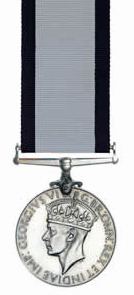Type Military decoration Status Discontinued 1993 | Awarded for Gallantry in the field Established 7 July 1874 | |
 | ||
Total awarded Victoria: 61Edward VII: 2George V: 110George VI: 183Elizabeth II: 3Total: 359 | ||
The Conspicuous Gallantry Medal (CGM) was, until 1993, a military decoration awarded to personnel of the British Armed Forces and, from September 1942, to personnel of the Merchant Navy of rank equivalent to that of petty officer or seaman. It could formerly also be awarded to personnel of other Commonwealth countries, below commissioned rank, for conspicuous gallantry in action against the enemy at sea or in the air.
Contents
The original Royal Navy medal was instituted briefly in 1855, and fully on 7 July 1874. During the Second World War, the Royal Air Force medal, the Conspicuous Gallantry Medal (Flying), was added from 1943.
The Medal was the other ranks' equivalent of the Distinguished Service Order which could be awarded for bravery to commissioned officers, although it ranked well below that in order of precedence, between the Distinguished Conduct Medal and the Distinguished Service Medal. Recipients of the medal are entitled to use the post-nominal letters "CGM".
In 1993, the Conspicuous Gallantry Medal, Distinguished Service Order (when awarded specifically for gallantry) and Distinguished Conduct Medal were all replaced by the Conspicuous Gallantry Cross (CGC). The CGC is tri-service and is awarded to all ranks. It is second only to the Victoria Cross for bravery in action.
Notable recipients
George Ingouville was awarded both the Victoria Cross and the Conspicuous Gallantry Medal.
Acting Chief Petty Officer Arthur Robert Blore won a Conspicuous Gallantry Medal in 1915 and a bar to it in 1918.
"Bugler Ernest Sillence. Royal Marine Light Infantry. Behaved with distinguished gallantry on 4th May (1915) during operations South of Achi Baba in volunteering to throw back enemy bombs into enemy lines at great personal risk, thereby saving the lives of many of his comrades."
"Sergt. Frank John Knill of the Royal Marines, R.M.A., No. R.M.A./12738. This non-commissioned officer was in charge of Vindictive's howitzer, which fired continuously under the most difficult conditions during the whole period that the ship was alongside the mole at Zeebrugge. In spite of being semi-gassed, Sergt. Knill did not leave his post, but remained in charge of his gun until it ceased firing."
CPO (Diver) Hammond was the last recipient of the CGM (1991 Gulf War) before the inception of the Conspicuous Gallantry Cross (CGC) in 1993. Only two CGM (Navy) have been issued during the reign of Queen Elizabeth II.
Corporal John Coughlan RAAF was awarded the Conspicuous Gallantry Medal in 1968, for actions as a helicopter crewman in Vietnam. This was the only CGM (Flying) to be awarded since the 1940s.
Wireless Operator F/Sgt Geoffrey Keen DFM was the first member of the Royal Canadian Air Force to be awarded the Conspicuous Gallantry Medal. During the bomb run in a raid on Essen on the night of 12/13 March 1943 his Wellington bomber was hit by flak, killing the navigator and blowing off Keen's right foot. For the remainder of the return flight, disregarding his wounds and whilst continually losing blood, for over two hours, Keen continued to repair his damaged radio set and on two occasions dragged himself to the navigators compartment to assist the pilot with essential information for navigating the aircraft safely back to base. All three remaining members of the crew were awarded the DFC while Keen was recommended for the Victoria Cross.
